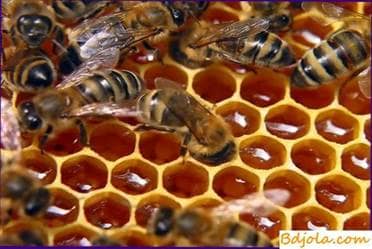Storage of forage stocks of bees
 Prepared for bees, peregu, pollen or pollen, it is important to be able to save, so that this perishable product may have lost its fodder quality. To do this, it is necessary that the storage of fodder reserves be dry, ventilated and inaccessible to pest infestation.
Prepared for bees, peregu, pollen or pollen, it is important to be able to save, so that this perishable product may have lost its fodder quality. To do this, it is necessary that the storage of fodder reserves be dry, ventilated and inaccessible to pest infestation.
In the process of air exchange, fungal spores penetrate into the storage and accumulate. Together with the beehive frames, especially with sour honey, various mites that harm perge are brought into the vault.
In favorable conditions for the development of microorganisms, what happens with warm and moist air, pergah, rejuvenation, pollen, honey and honeycombs quickly deteriorate. To prevent this from happening, every autumn, before storing fodder stocks in the storage, carry out a thorough mechanical cleaning of the premises and disinfect it by burning sulfur at a rate of 50-70 g per 1 m3. To avoid damage to dressing gowns, nets, leather and metal goods, they are removed from the room for the duration of the treatment.
After carefully ventilating the storehouse, feeds are placed within it, placing them in cabinets, drawers or in columns of buildings and shops. If measures are taken against penetration into the room of mice and moths, the frames are suspended on the shelves.
Relative air humidity in the storage should be within 50-60%. In this mode, the perg does not mold and does not dry out, and the unsealed honey almost does not absorb moisture and does not give it away. With an increase in air humidity, honey begins to absorb water and turns sour under the action of yeast microorganisms. Yeast feed on sugar, highlighting wine alcohol, fusel oils, water and carbon dioxide. Later, the wine alcohol undergoes acetic acid fermentation, turning into acetic acid. As a result of these processes, honey becomes unsuitable for feeding bees. In addition, sour honey will be a favorable environment for the development of dairy mites.
Perga can be affected by a ham carnivore, a black beetle 8 mm long. The name of the pest indicates that the ham eel feeds on meat products and skin. In hives, it can be found in weak, polluted families from spring to autumn. He feeds on dead bees and perga. When entering the vault, the mite eats and destroys the penguin.
Turn pergu into dust are capable of small, about 1 mm long, almost white, wingless insects – hayloids.
The best temperature for storing honey in honeycombs, pearls, pollen and pollen is 1-5 њ C. At a temperature of 13 to 15.5 њ C honey quickly crystallizes, and the liquefied is subjected to fermentation. Increasing or lowering the temperature delays the crystallization process.
Perga and pollen, stored at room temperature, significantly reduced nutritional value. Thus, on a feather stored at a temperature of 0 to 12 њ C, the brood grows almost 3 times more than on the perge, which was stored at a higher temperature.
Not every farm has proper premises for storing bee stems. They are often stored in unheated rooms, where they are exposed to variable temperatures and freezing. As a result, honey crystallizes, and on perge, if it is frozen, the bees barely grow brood because of lost vitamins.
In the past, the pergola frames were stored in the attic of the underground zymovnik in warm over tight boxes, as well as in a working room with a temperature of up to 20 њ C. After the underground storage for fodder stocks was built, it was noted that the results of the development of bee colonies on feed stored under favorable conditions were incomparably better, besides they were not affected by pests.
Many beekeepers keep their pergola frames in the hibernate along with the bees. To prevent the molding of Perga, it is powdered with ground sugar (powdered sugar). It is more convenient to carry out this work through a sieve with small cells. Other beekeepers place frames with perga in well-fitted hive shells, glue the slits, and cover them tightly with glass.
Well preserved perga within the framework, placed in polyethylene tightly tied bags. However, whatever the raw air in the room, it does not penetrate into the bags and will not spoil the food.
In practice, some amount of pollen remains unused. In this case, the pollen is stored in milk flasks or in containers with lids having rubber gaskets, which protect the pollen from penetration of raw air into it. For better preservation of pollen on the bottom of the tank, it is good to put in a small amount of “dry” carbon dioxide, used in greenhouses for foliar top dressing of plants. In order not to freeze the adjacent pollen, carbon dioxide should be wrapped in a rag.
Gradually the “ice” melts, carbon dioxide, which has a greater specific gravity, is distributed among the seeds of the renewal, displacing the air. At this time, the cap of the container is closed, which creates better conditions for the preservation of nutrients and biologically active substances in the feed. VNII Veterinary Sanitation for the reliable preservation of Perga and Renovation recommends keeping them in polyethylene labels, which are filled with methyl bromide (gas) at a rate of 20 g per 1 m3 of bag. The bag is tied. Methyl bromide can be purchased at plant protection stations.
Storage of forage stocks of bees
